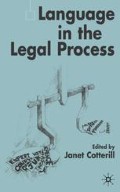Abstract
One major type of evidence presented by the police at trial is their record of what the accused said. This evidence comes in two forms — records of interviews with suspects and records of statements made by suspects. Since the Police and Criminal Evidence Act (PACE, 1984) which was introduced following a spate of claims that those accused of crimes were frequently ‘verballed’ (that is, verbal evidence was fabricated by police officers), the police in England have been required, whenever possible, to make a contemporaneous audio or video recording of verbal evidence. However, the three cases that I will discuss in this chapter predate PACE and come from a time when it was customary to record what was said in interviews laboriously in longhand. I was commissioned as an expert in all three cases when they were referred, successfully, to the Court of Appeal in the late 1990s.
Access this chapter
Tax calculation will be finalised at checkout
Purchases are for personal use only
Preview
Unable to display preview. Download preview PDF.
References
Austin, J. L. (1962) How to do Things with Words. Oxford: Oxford University, Press.
Blackwell, S. (1996) ‘Corrective Measures: Some Aspects of Transcription in the British Legal System’, in H. Kniffka, S. Blackwell and R. M. Coulthard (eds), Recent Developments in Forensic Linguistics. Frankfurt, Peter Lang, pp. 255–76.
Coulthard, R. M. (1993) ‘On Beginning the Study of Forensic Texts: Corpus, Concordance, Collocation’, in M. Hoey (ed.), Data, Description, Discourse. London: HarperCollins, pp. 86–114.
Coulthard, R. M. (1996) ‘The Official Version: Audience Manipulation in Police Reports of Interviews with Suspects’, in C. R. Caldas-Coulthard and R. M. Coulthard (eds), Texts and Practices: Readings in Critical Discourse Analysis. London: Routledge, pp. 164–76.
Davis, T. R. (1994) ‘ESDA and the Analysis of Contested Contemporaneous Notes of Police Interviews’, Forensic Linguistics, vol. 1 (1), pp. 71–89.
Eades, D. (1996) ‘Verbatim Courtroom Transcripts and Discourse Analysis’, in H. Kniffka, S. Blackwell and R. M. Coulthard (eds), Recent Developments in Forensic Linguistics. Frankfurt, Peter Lang, pp. 241–54.
Pagano, A. (1994) ‘Negatives in Written Text’, in R. M. Coulthard (ed.), Advances in Written Text Analysis. London: Routledge, pp. 250–75.
Trow, M. J. (1992) ‘Let him have it Chris’. London: HarperCollins.
Editor information
Editors and Affiliations
Copyright information
© 2002 Palgrave Macmillan, a division of Macmillan Publishers Limited
About this chapter
Cite this chapter
Coulthard, M. (2002). Whose Voice Is It? Invented and Concealed Dialogue in Written Records of Verbal Evidence Produced by the Police. In: Cotterill, J. (eds) Language in the Legal Process. Palgrave Macmillan, London. https://doi.org/10.1057/9780230522770_2
Download citation
DOI: https://doi.org/10.1057/9780230522770_2
Publisher Name: Palgrave Macmillan, London
Print ISBN: 978-1-4039-3388-1
Online ISBN: 978-0-230-52277-0
eBook Packages: Palgrave Language & Linguistics CollectionEducation (R0)

